Author Archives: Holly Christensen
Author Archives: Holly Christensen
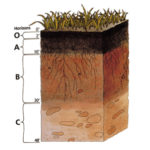
One of the biggest hurdles for planting in the urban environment is soil compaction. Heavy equipment used during the building process, or for mowing and landscaping, can cause the soil to become so compacted as to not allow roots to spread, not allow water to be absorbed or drain away, deprive the plant of oxygen in the root zone, and subsequently not allow nutrient absorption. Even foot traffic causes significant compaction. Some of the largest trees in the world have been killed by the foot traffic of people coming to see the tree, and steps have to be taken to protect them. When your dog runs the same path over and over the grass doesn’t grow due to compaction, and even animals as small as squirrels and chipmunks can make tiny trails where plants don’t grow.

The effects of soil compaction
One of the best methods of addressing soil compaction is a process called vertical mulching. It’s a form of aerating similar to the plugs pulled out by lawn aerating, just on a bigger scale. It’s done by drilling holes, ideally with a two inch diameter auger (something heavy duty) in a grid pattern with the holes 2 feet apart and up to two feet deep. Obviously call Miss Dig to locate utilities (248-370-6400 or 800-482-7171), and be prepared to do some irrigation repairs if necessary.
This is how it helps. Immediately it allows oxygen, water, and added nutrients access to the plants root zone. This is just the beginning of a long lasting process. In the winter, water freezes in the holes and expands causing the soil to fracture. These fractures in turn fill with water, freeze, expand, and cause further fracturing. The more this happens, the more oxygen and water are available in the root zone. The longer the holes can be kept open, the longer the process will go on. They can be kept open by adding aggregate or using soil aeration tubes (see photo). The tubes may not be cost effective for large areas, but they are better than aggregate as they leave the hole completely open to allow more water and air to reach the root zone. Also, they are capped against debris filling them up and can be uncapped to add nutrients. Eventually roots will render them useless, but by then they will have done their job.

As far as drilling the holes, you can do it manually using the biggest electric drill you can find. I rented one once that had two handles like a jackhammer with the trigger in one of the handles. A posthole digger on a tractor or other piece of equipment would work well for large areas.
For lawn aeration, pulling plugs is an excellent option for lawn health (note: this should be done when the ground is moist so the plug can be cleanly removed), but for landscape beds vertical mulching is the best method to properly aerate, and if done manually can be done in established beds. Using this method you can overcome the hurdle of soil compaction and your plants will thank you for it by growing big and beautiful.


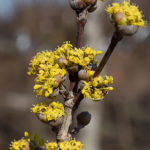
I still remember planting my first serviceberry with my dad a long time ago – actually, a very long time ago. What struck me most were the many names for the same plant – Amelanchier canandensis, Shadblow, Juneberry, Serviceberry. Somewhat unusual at that time, little did I realize what a high-demand plant it would become. Therein lies the problem. It seems no matter how many are brought in every year we quickly run out. Landscape contractors, designers, and architects ignore so many other great similar-usage plants. Even when repeatedly told we are out till fall dig season, the requests keep coming. There are many good substitutes. In fact, there are many plants that would be better first choices!

'Arnold Promise' Witchhazel

'Arnold Promise' Witchhazel
Even more shade tolerant than Amelanchier are witchhazels. Larger, fall-blooming, native Hamamelis virginiana could match serviceberry with respect to growth rate and size. H. vernalis and the many crosses of H. mollis and chinensis (i.e.’ Diana, Jelena, Arnold Promise,’ et al.) are slower-growing but offer patio shade and a much greater color range. Native multi-stemmed dogwoods (Cornus florida and fl. ‘Rubra’) give a layered look; same usage but different than the arched or cascading habit of A. canadensis.

Cornus florida 'Princess Emily'
Also, a terribly-ignored, rugged, and problem-free group of plants are the Wrinkled Viburnums. In particular, Viburnum rhytidophyllum, Leatherleaf, and V. x rhytidophylloides ‘Willowwood’ are monsters. Achieving height and spread toward fifteen feet, they have an arching habit and are semi-evergreen. These offer spring flower, fruit, fall color, (and winter foliage interest).

Viburnum rhytidophyllum - Leatherleaf Viburnum
A perfect match for Amelanchier ‘Rainbow Pillar’ is Cornus mas ‘Golden Glory.’ This Male Dogwood is very hardy and an early bloomer not usually susceptible to freeze damage. It has exfoliating bark and edible fruit. Its structure provides great winter interest.

Cornus mas 'Golden Glory'
Another easy sub for Amelanchier is Viburnum prunifolium, native Blackhaw, large, global, and a great bird attractor. A shrub easily surpassing fifteen feet in height and spread.

Viburnum prunifolium - Blackhaw Viburnum
So, yes, there is life after serviceberries. I can't promise you that these or any other plants are going to be in stock when you are looking for substitutions, so don't be afraid to consider other options. Let's enhance our landscapes in terms of variety and plant health!

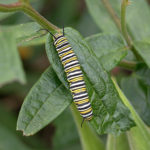
It’s not always all grinding and going at Christensen’s Plant Center, sometimes we crew members get to stop and smell the flowers - and during the summer - find some of them crawling with beautiful monarch caterpillars.
Monarchs are not yet an endangered species, but they and their migration are being threatened and need protecting. So at Christensen’s we started rounding up our Monarch caterpillars and putting them into mesh butterfly cages with a milkweed plant for food. Monarchs feed solely on Asclepias, using the toxins in the milkweed to make themselves very unpleasant to predators. Animals and birds who eat a Monarch caterpillar or butterfly get pretty sick from it and won't eat another. There are still a lot of losses, though, so raising and releasing them really helps boost their numbers.



They are voracious feeders, so we check them daily, replacing the host plant as needed. Once they’re nice and fat, they’ll eventually J-up (they hang, head down, in a ‘J’ shape) and morph into a chrysalis within hours. Then after about 10 days, you’ll have a beautiful Monarch butterfly. Easy, right? One day when we came into work, we had three hatched and ready to take off!


Chrysalides start out green, turning clear as the butterfly develops

Male Monarch emerging from his chrysalis
Be careful of escapees though - we had one little guy escape and he ended up morphing into his chrysalis under the table. If you have a cage with a zipper, make sure there’s no one by it when you unzip it or a caterpillar could get caught in it (yes, sadly we learned that one from personal experience). Also beware of invaders: spiders and flies love to sneak in which can be dangerous for the butterflies-in-training! Other predators include wasps, assassin bugs, ants, toads, and even mice.

Plants like Allium, Buddleia, and Liatris seem to be swarming with Monarch butterflies this time of year. Monarchs are an important pollinator for many wildflowers. Providing a safe place for Monarchs to grow and multiply is a rewarding and beautiful experience.
See here for more about growing milkweed: Milkweed for Monarchs - Michigan DNR

Fresh new Monarchs! Female (above) and male (below). Males have a tiny spot on their hind wings.

Common milkweed is a favored host plant for Monarchs


Christensen’s Plant Center is very excited to welcome "Brutus" to our hard-working family. But first, let me tell you about some of our other family members.
Each one of these family members was selected to make getting your landscape material to you efficiently and professionally. There are: Betsey, Agnes, Orange Crush, Big Blue, The Twins, Red Brick, Gray Flat, Lola Ryder, and Thing 1 and Thing 2 - among others. Obviously some of us here like nicknames and in this case we have given nicknames to most of our delivery equipment.

We have three box trailers that each have drop decks and large side doors to make unloading much easier. We have five flatbed trailers designed to haul large loads of trees, shrubs and other nursery stock. We have two more flats that are designed to haul brick, wall block and other hardscape materials while toting one of our two Moffett forklift machines that we use to unload hardscape product for you on your job site.

We currently have five semi-trucks ranging from Ol’ Betsey, the matriarch of our fleet, to the Twin Freightliners, to Agnes - our first heavy hauler - and finally, our newest member, Brutus.

Brutus is a real life Michigan Special. He's a 13 speed, 18K front axle with 44K rears. 575HP with turbos that whistle when idling. Brutus is set to haul the biggest of brick loads without breaking a sweat. He’s a prefect addition to our BIG truck family.

So no matter what landscape material you need or where you need it, we have a family member to get it to you.
As a welcome to the family celebration, if you tell your salesperson that “Brutus is a Brute” we will waive the delivery charge on your next delivery. This offer is limited to one per customer and only good until 11-29-2019.
Coming soon to our family... “Axle"... Stay tuned.

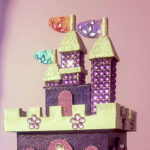
My youngest daughter loves to do arts and crafts. Her favorite part of the project has always been to add “bling” to whatever it may be. Her material of choice varies between glitter, jewels, bows and stickers. It’s just not complete until it sparkles and shines like something out of a Glamour magazine. She enhances just about everything, including my dog! She likes to add her personal touch, make it look better than what it was, and I say why not?
As hardscape and landscape designers, do you have a certain type of “bling” that is specific to your projects?

I can't talk to you about all the different things you can do with plants, shrubs and ornamentals as I have very little experience in that department, although we do have over a dozen highly knowledgeable sales staff that do. What I can talk to you about is brick. With so many different sizes, colors, shapes and textures it’s not hard to find a way to enhance any size or type of project. However, there is so much more to work with than just the concrete product itself, so let me enlighten you.


Yes, that was a well-placed pun, but seriously, lights can make a HUGE difference in any hardscape or landscape project. You can bling out a wall, walkway or outdoor living space very easily with LED step lights and up lights. We have pillar cap lights and wall sconce lights, color changing bulbs and wireless control features. You could add more illumination with a natural gas or propane fire pit or fire bowl. We stock many types of Firegear products that will add some more sizzle so your pazizzle doesn’t fizzle. Speaking of fire, how about a pizza oven with a fireplace, already scratch-coated and ready to install into the brick or stone of your choice? Maybe that’s a bit too hot, so cool it down with a fountain or small waterfall kit. They are easy to maintain and easy to install, which makes them an easy sell.

With so many types of enhancements available, finding the right one should not be hard. Many of these upgrades can be added to existing projects and what better way to reach out to your previous customers then to show them new shiny “bling”. Show them that they can sit outside by a fire, change their lights to match their college team’s colors and wait for a pizza to finish cooking all while listening to the big game.


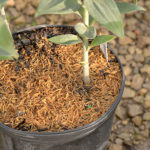
You may nave noticed something different in our perennial pots recently. Covering the soil of some of the varieties we grow are tiny rice hulls. Sounds delicious, right? No, it's not the starchy side dish.
Rice hulls are a sustainable soil amendment with many advantages. Here at Christensen’s Plant Center rice hulls are used mostly as a top dress to prevent weeds. Our perennial production department applies them at the time of potting. Used properly, they can help control a weed problem before it even begins. If you can manage to get more rice hulls in the pot than on your person, these can be very effective.

Rice hulls can also be used in the landscape. Mixed into the top 6-12” of your garden or planting beds, the advantages include better drainage, water holding capacity, and soil aeration. And for all of you environmentalists out there, rice hulls are 100% organic and biodegradable.
As a top dress, rice hulls are great for holding moisture and preventing weeds, but there are a few downsides. THOSE THINGS ARE A MESS! Once you open up the bale, you will find it in every pocket and every shoe of those around it. Also not the best thing to use on a windy day... We've found that the most effective plants to use it on have been hosta and daylily.

Sometimes the rice hulls work a little TOO well. With plants that cannot handle a wet crown, rice hulls should not be used. Since rice hulls are to be applied ½-1” thick, that can be too much moisture. For plants like sedum, rice hulls are not recommended.

Rice hulls are a cost effective, easy way to maintain plant moisture and keep away weeds. Just not the best to have for lunch.



I have a problem. One the one hand, I have landscaping that I like to keep looking, well, ornamental. On the other hand, I prefer to avoid using herbicides and insecticides whenever possible. Now factor in the lack of gardening time that comes with working at a nursery and you can guess what my yard looks like by summer.
A lot of weeding can be avoided by keeping beds mulched, but what about driveways and paths? You can pull the weeds, if you can find the time to stay ahead of them. You can treat with herbicide, and depending on what product you choose, deal with too little - or too much - control. Or... you can do it the fun way - with a propane torch.
Editor's note: CPC is not endorsing this method. Use caution if you decide to try it.


What I like about this method is the instant results and minimal regrowth that comes with superheating the ground, simultaneously cooking weed roots AND seeds lying in wait. The crackling flame as your enemy combusts is also quite satisfying. You'll want to do this on a windless day, to avoid getting into trouble with smoke or sparks.
It should be noted that this is a two-man job, one person running the torch and the other manning the hose. Thoroughly douse everything down after the torch passes so you don't accidentally burn down the neighborhood. I am not kidding about this.

The torch has an adjustment dial on the wand, you want to keep your flame just large enough to burn invisibly but not go out. As the pressure drops you can turn the dial to get more oomph. If your tank ices up stop and defrost it to get some pressure back.

This technique takes a little practice and is not for the faint of heart, but can't be beat for fast cleanups of driveways, paths, and paved areas. The torch shown is designed for clearing large areas, there are others on the market that have a smaller, more targeted flame.


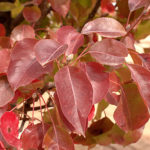
We do this all the time!
We over use, we abuse, we’re in a hurry, and we’re lazy! The landscape/nursery industry is a repeat offender! We have our “go-to,” easy-money plants. On the surface that doesn’t seem to be a bad thing. Almost every contractor has their favorite group of plants; almost every contractor is stuck in some sort of rut! Week after week we get the same list from contractors. Only the numbers change!
Need proof? Recent history provides great examples! Let’s start with the Green Ash. (I hope you don’t need an explanation!) Another great example is the Norway Maple. Our storage field used to have hundreds of Norways of many varieties. It’s “go-to-ness” turned it into an invasive species banned from most cities due to its ability to reseed into alleys and easement areas. The resulting offspring were often not very landscape worthy. Tree growers were left with fields of trees with no market in which to sell them!

Pear in our tree field in 2014
Looming on the horizon is the fate of the beloved Callery Pear. The Bradford Pear’s (a.k.a. “Banana-Split Pear”) popularity succumbed to the hyper-popular Cleveland Pear. It’s been the near-perfect tree: Popular, household recognition! Transplanting into most any soil, great form, great bloom quality, and rich, long-lasting fall color!

The overuse of this species has led to outbreaks of Pear Rust, and its ability to reseed has begun to clog open spaces with again undesirable offspring. States and cities have begun restricting its usage. And then there’s probable, correcting fireblight….
What’s next? Will growers develop a truly seedless Callery? Or, what will be the new big seller? Haven’t we learned anything? We don’t need another “go-to” plant. This industry needs good practices and diversity!
We already offer a number of trees that would substitute well for the Cleveland Pear. Some of these are:

Acer rubrum 'Brandywine' (L) - Acer saccharum 'Legacy' (R)

Carpinus caroliniana - American Hornbeam

Cornus mas 'Golden Glory' (L) - Syringa reticulata 'Ivory Silk' (R)

Taxodium distichum 'Shawnee Brave'
Resist the temptation, don’t be a repeat offender! Mix it up out there!

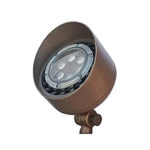
Technologies change rapidly, and landscape lighting isn’t any different. LED lamps have become brighter and are less expensive. Now the engineering geniuses have tapped into the color change technology. With the right lamps, clients can choose from a wide spectrum of color effects or simply adjust the temperature of white for just the right look.
We started here at Christensen’s with Halco’s color changing MR16 lamp that uses a remote control. Last year, Alliance Outdoor Lighting introduced their BL200-BT bullet fixture, which integrated a color changing MR16 that is controlled via Bluetooth with a smartphone app. Each fixture has an antenna, which makes all the linked fixtures synchronize for easy programming and coordination.

Our partnerships with Alliance Outdoor Lighting and Brilliance LED LLC are bringing even more options to the color-change palette, through both fixtures and LED lamps.
Alliance has two new fixtures to accompany their award winning BL200-BT, which also use the smartphone app for easy synchronization between all fixtures. The first is the BL300-BT, which is a PAR36 spot fixture. For areas that need that extra punch of lumen output and/or a touch extra spread, this is the one you want. It boasts up to 410 lumen output while only pulling 8 watts, which comparable to most, if not all, 8 watt MR16 LED lamps on the market today.
Alliance’s second new fixture is the PL100-BT, which is one of the first of its kind in regards to path illumination. The PL100 has the advantage of an adjustable head, both horizontally and vertically, to truly pinpoint a specific area for the desired lighting effect.
This year, Brilliance LED LLC has launched the Chameleon Series lamps. There are a MR16 LED lamp and a PAR36 lamp, and both are phone app driven via Bluetooth. This is an exceptional option for both new installations of lighting product lines that do not have color change technology, or for retrofitting an existing system. The 6 watt MR16 boasts a powerful output of up to 441 lumens, while the 9 watt PAR36 lamp produces an even more impressive output of up to 686 lumens.


Even more fixtures and lamps are expected to be released later in 2019, such as an underwater and flood fixture, but specifics and date have yet to be announced. Stay tuned! Your customers will love the flexibility and creativity of color-change LED technology.

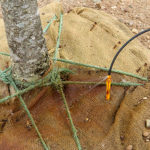
Ever wonder how Christensen’s stores and maintains trees in "the field" to keep them viable all year long? If you've ever tried to keep above-ground material healthy over a long period of time you know there are challenges to be met. But for the most part, it’s really not that far off from what you do when you plant a tree in a landscape - except we do it for a few thousand trees.
First, we grade out the area where the trees are going to go and then auger holes to place the trees in. After the tree is straight in the hole we backfill it with dirt and lightly pack it down.


Then an irrigation emitter is placed into every root ball. We use two different sizes of irrigation emitters, yellow for trees that are 3” or smaller and black for anything larger. We do an irrigation check on the trees at least once a week depending on the time of year. The irrigation system for the field might run 24 hours a day in the summer, so making sure that the trees get the required amount of water is sometimes difficult. We check the emitters to make sure they are not clogged, that they are spraying correctly, and that they haven’t come off of the feeder line and are flooding the tree.

After the trees are put in the ground we apply pre-emergent to prevent weeds from growing in the root balls and the surrounding soil. We generally do this twice a year. As the year goes on if weeds begin to grow we spray with non-selective herbicide. We add a non-toxic blue indicator dye to make sure that we are only hitting the targeted weeds and not the trees.

We do several other sprays throughout the year to prevent disease or insect damage. For instance, we spray for apple scab in the early spring as the trees just start to leaf out. There's also a scheduled spray to prevent gypsy moth, when the temperature is right. We do other targeted sprays as issues come up. Our nursery is inspected regularly for pests so we can be sure that our material is ready for distribution.

At the end of the season we put tree guards on the trunks to prevent damage that could be caused by roaming rabbits and deer. In the spring we remove any guards that are made from solid material in order to allow the trunk of the tree to stay dry and also to prevent bugs from making a home there.

Lastly, when we lift trees from the field to go on your truck, we carefully re-wrap the rootball with fresh burlap if needed. You can be confident that the trees we store are ready to go on your landscape job, spring, summer, or fall.

